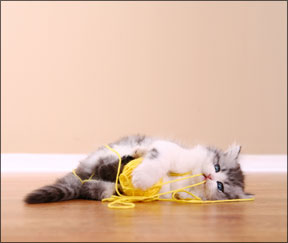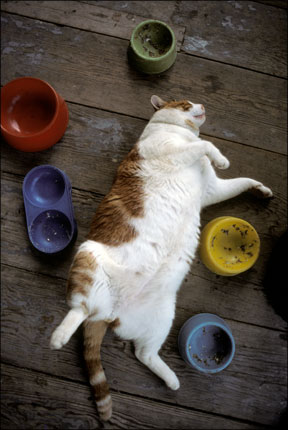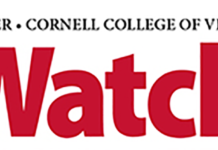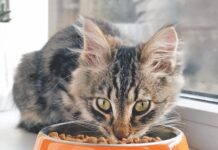The Danger in String Ingestion of foreign bodies – including string-like objects – is a common problem seen in feline veterinary medicine. Foreign bodies may cause partial or complete gastrointestinal (GI) obstruction, which results in disturbances of fluid and electrolyte balance as well as dehydration. Damage to the intestinal tract can also occur. This study (“Gastrointestinal foreign 288 bodies in dogs and cats: a retrospective study of 208 cases” in the Journal of Small Animal Practice, 2009) reviewed the records of 208 cases of GI foreign bodies in dogs and cats that were brought in to the RSPCA Greater Manchester Animal Hospital in the UK from June 2003 to May 2007. Twenty-one cats were included in the study, with three cats being examined on two separate occasions. Twenty-five percent of the cases in cats involved a linear foreign body. The types of foreign objects included plastic or rubber objects, string, rope or fishing line, and needle and thread. Survival rates were higher with foreign bodies (100 percent) than linear foreign bodies (63 percent). Increased mortality was also associated with a longer duration of clinical signs and multiple surgical procedures. The degree of obstruction and the location of the foreign body had no influence on survival. The authors conclude that prompt veterinary attention, diagnosis and surgical intervention improve the outcome of animals with GI foreign bodies. Cat owners should take care in leaving pets unsupervised with small toys and string. Weight Loss Diets: Do They Work? Obesity is an increasingly common health problem in dogs and cats, with between 22 and 44 percent of the dog and cat populations in the United States currently overweight or obese. The objective of this study (“Evaluation of calorie density and feeding directions for commercially available diets designed for weight 288 loss in dogs and cats” in the Journal of the American Veterinary Medical Association, 2010) was to determine the range of calorie density and feeding directions for commercially available diets designed for weight management in dogs and cats. Forty-nine feline diets had a weight management claim with feeding directions for weight loss or implied weight management claims. The feeding directions for weight loss were compared with resting energy requirements (RER) for current body weight by use of a standard body weight of 12 pounds (5.5 kg) for feline diets. More than half of all foods in the study had a caloric density greater than the AAFCO maximum caloric density for light diets. This would make successfully achieving weight loss without carefully controlling caloric intake difficult. Another problem noted in the study was a wide range in feeding directions and a high variability in estimates of calorie requirements for weight loss. Therefore, successful weight loss is unlikely with most diets. Most pets require caloric restriction to less than the RER for current body weight and others must have substantially less than the RER to achieve weight loss. It is always necessary to adjust feeding recommendations for an individual animal. Weight loss requires lifestyle changes such as an increase in physical activity. Ultimately, the authors recommended that pet food companies could assist in improving pet health by developing foods with lower caloric density on a volume basis, making accurate feeding directions based on optimal weight rather than current weight, and providing caloric information on all labels of pet foods and treats. 






